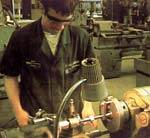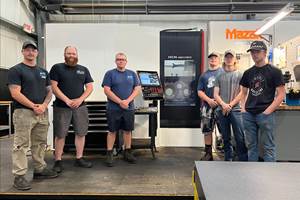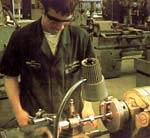The ROI For Manufacturing Training
From the viewpoint of the individual, the employer or the country as a whole, training in manufacturing skills is a good investment.
The return on investment (ROI) for the training of new and incumbent skilled manufacturing employees is higher than on most capital investments. The ROI is high for the employee, the employer and our country. In contrast, ROI is much lower on the education of, let's say, a 4-year university English major. Yet society subsidizes hundreds of thousands of extra English majors instead of giving companies incentives to hire apprentices. Even machine shops don't invest enough in the training of their incumbent workers to maximize ROI.
From The Worker's Viewpoint
High school graduates are faced with the decision of whether to pursue a skilled trade, such as precision machining or tool and die making, via an apprenticeship or by obtaining an associate degree, or to pursue a 4-year university degree, typically in a liberal arts field such as English. In the United States, the overwhelming choice for most students is the 4-year degree. Table I calculates the average total investment by the individual student in terms of expenditures and loans for tuition plus income not earned while in school. The median annual lifetime income is then compared to that of a high school graduate in order to determine the incremental after tax income that is the ROI in post-high school training. The ROI is the after-tax annual incremental income divided by the total investment. It is assumed that the apprentice also obtains an associate degree and has to pay all related expenses, but works full-time at the average wage of high school graduates during the apprenticeship.
Clearly, the associate degree in manufacturing technology and the apprenticeship offer a much higher ROI than the bachelor's degree in English.
From The Country's Viewpoint
The calculation here is very similar to the calculation above, except:
- The tuition subsidy from the local, state or federal government or from private university endowments is added back in to reflect society's entire cost to provide the training. In the case of the apprentice, it is assumed that the employer is not subsidizing the apprentice. This assumption probably works out to be reasonable over a 4-year apprenticeship.
- Because we are looking at the investment and return from the country's viewpoint, all incomes are calculated at gross income, including the taxes, which flow to the government.
- The multiplier effect creates incremental jobs.
As shown in Table II, the ROI is 5 to 8 times higher for the associate's degree in manufacturing technology or for the apprenticeship than for the bachelor's degree in English. Nevertheless, our state governments provide about $60 billion per year in funding to colleges and universities, and the federal government provides another $81 billion per year, $57 billion of that in the form of loans.
In today's extremely competitive world market, it clearly makes more sense for our state and federal governments to shift their resources to tax credits for shops to hire apprentices and to provide 100 percent scholarships for manufacturing technology degrees.
From The Employer's Viewpoint
Training new and incumbent workers is clearly necessary for companies to survive. Society is not providing the training. If your shop expects to be in business in 10 or 20 years, it must have the best available workers with the highest possible level of training.
The company's ROI on incumbent training is about equal to what an apprentice receives on his/her training. We have surveyed users and determined that approximately 35 percent of full-time Charmilles operators have never attended operator training classes sponsored by our company. Typically, an operator was trained when the machine was purchased. The previous operator then trained each subsequent operator, even though our company regularly provides inexpensive training on almost all models sold since the mid-1980s. Based on our experience, especially on older models, the productivity of an operator who has had 1 week of training will be about 20 percent higher than an operator with the same experience but no training. In the analysis below, a 10 percent productivity increase is assumed. In addition to higher productivity, a shop should expect training to yield higher quality, better machine reliability and better employee morale. On the newest models, the productivity improvement is less because the controls are more user-friendly.
In Table III, the investment in incumbent training is calculated assuming the worst case, that during the 1 week of training, $2,000 of sales are lost. Normally, with planning and any available cross training, most of the sales loss should be avoided. The travel cost covers airfare, hotel room, meals and so on. The 10 percent productivity increase is applied to $100,000 of sales per year per employee. Actually, the entire company should be generating more like $130,000 per year per employee, including front office employees. If 15 to 20 percent of the employment is not on the shop floor, then the relevant sales per EDM operator employee are actually $150,000 per year, increasing the ROI substantially.
If the ROI is so high on incumbent training, why isn't more done? Some shops say they are too busy and can't afford for the operator to be away for training. The best way to get caught up is to increase productivity by 10 or 20 percent via training. Other shops say that a productivity increase might not pay off because they cannot achieve more sales. If sales are that slow, then the investment is much lower because fewer sales will be lost while the employee is away. The resulting improved turnaround time, quality and cost might be the solution to obtaining more orders.
Invest In Training
Clearly, workers, companies and our country are not making the right decisions about training. In today's increasingly competitive world, each individual, each company and our country must make much better investment decisions if we are to even maintain our current quality of life.
About the author: Harry C. Moser is North American president of Charmilles Technologies Corporation and Mikron Corporation (Lincolnshire, Illinois).
Sources: Data for the calculations was obtained and, in some cases, extrapolated, from Trends in College Pricing 2004 by the CollegeBoard, Trends in Student Aid 2004 by the CollegeBoard, U.S. Bureau of Labor Statistics, NSF/SRS and Tool and Die Maker incomes tabulated by Charmilles from the annual surveys of the NTMA, TMA, AMBA and PMA. All data are for 2003 incomes and the 2003/2004 school year. More information and promotional materials for careers in manufacturing technology can be obtained by e-mailing the author at info@charmillesus.com.
Related Content
A Career at the Top Helps Rebuild a Job Shop
A new approach to management propels expansion into Swiss-type and multitasking machining work.
Read MoreIf the Federal Government Is to Solve the Manufacturing Labor Shortage, it Needs to Start Here
Student-run businesses focused on technical training for the trades are taking root across the U.S. Can we — should we — leverage their regional successes into a nationwide platform?
Read MoreTop Shop Builds Upon Employee Ownership for Future Success
In its quest to become the Fox Valley’s best-in-class employer, A to Z Machine has adopted an ESOP, expanded benefits and invested in apprenticeships.
Read MoreSolve Worker Shortages With ACE Workforce Development
The America’s Cutting Edge (ACE) program is addressing the current shortage in trained and available workers by offering no-cost online and in-person training opportunities in CNC machining and metrology.
Read MoreRead Next
Training Time
The graying of skilled metalworkers adds impetus to the growth of standardized training programs.
Read More3 Mistakes That Cause CNC Programs to Fail
Despite enhancements to manufacturing technology, there are still issues today that can cause programs to fail. These failures can cause lost time, scrapped parts, damaged machines and even injured operators.
Read More










.png;maxWidth=300;quality=90)





.png;maxWidth=300;quality=90)












